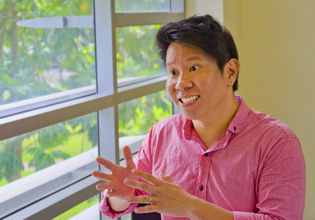Why Singapore’s English Teachers Should Embrace Singlish, Not Fight It
Is it time for Singaporean educators to embrace Singlish as a legitimate learning tool? What the Research […]
Read More
Creativity has been a hot topic since the Ministry of Education articulated its vision of Curriculum 2015, but many teachers are still not confident about teaching and evaluating creativity. John Yeo explains how we can better respond to the call for creative teaching.
Creativity is a complex and multi-dimensional construct. It isn’t just about coming up with multiple solutions to a problem, says NIE lecturer John Yeo. Neither is it about the outcome alone and how innovative it is.
“We want our students to learn more creatively, and we think that means we need to teach more creatively,” he notes. “Sometimes people even talk about a need to teach creativity.”
John makes a distinction between these notions of creative teaching and teaching for creativity. “Teaching creatively and teaching for creativity are related but they’re not the same thing.”
They do, however, share a common focus – helping students learn by appreciating new points of view and values. And that’s what John is interested in.
John believes we can help our students to learn better by teaching them to think creatively. For him, it begins with teachers’ understanding of the creative process as that affects the way they teach – and thus the learning that results.
 Many teachers equate creative teaching with engaged learning, but an engaging lesson does not necessarily lead to effective learning.
Many teachers equate creative teaching with engaged learning, but an engaging lesson does not necessarily lead to effective learning.
“Sometimes teachers think that creative teaching is only about engagement, but it doesn’t always mean that being engaged results in effective learning.”
In terms of creativity in education, John explains: “It is primarily about helping students to look at things differently. How do they understand the issues and identify challenges? And then, how do they generate better ideas?”
Though some think that teaching creatively is good to have but not a must-have for students to pass exams, John begs to differ. When students are thinking and learning creatively, they become effective learners. To do that, we need effective teaching.
“Effective teaching requires a child to understand the concept and to make meaning of that. That’s a very creative process for the learners.”
John is especially interested in the process of creativity. For him, it’s really about creative thinking.
“I focus a lot on the process, or process learning, because you don’t get creative ideas out of nowhere,” he explains. “But if you go through the process, it helps us to then formulate better or more meaningful solutions.”
John uses a model of creative problem solving (developed by Puccio, Murdock, Mance, 2005) to help teachers understand the process of creativity.
– John Yeo, Curriculum, Teaching and Learning Academic Group
Creative problem solving is an iterative process that involves both divergent and convergent thinking, where the situation is continually analysed and assessed. It is also an imaginative process as new solutions are constantly explored and elaborated upon.
John sees this creative problem-solving process as a powerful tool for developing skills in both critical thinking and affective skills. It is especially helpful for teachers who are perhaps more comfortable with evaluating the product of the creative process.
But because creative thinking is a process skill, John maintains that we can’t just provide a rubric and expect teachers to assess students based on that.
“If you talk about 21st century teaching and learning, the teachers themselves must have the competencies. They need to understand it for themselves,” argues John. Only then can teachers truly embody the attributes they teach.
Some may insist that creativity cannot be taught. “I argue that it can be nurtured,” John affirms. “It can be nurtured as a child speaks with others, as the child interacts with the content.”
We want to develop creative learners – students who see themselves as creative individuals, and who dare to take risks and explore the new and unpredictable.
For John, the greater concern has to do with curriculum design. “The question then is, how do you design that as part of your curriculum? How do you create processes to bring about that learning?”
This requires a tolerance of mistakes, among other things, by both students and teachers. Teachers also need to be mindful not to over-instruct, as that could inhibit students’ creativity.
Going back to the creative problem-solving process, John says: “If I use a process, at least the teacher can continue to go back and forth, and say, what am I doing well, and how is my process driving that learning process. The process will frame how the teacher guides the learning.”
The process certainly takes more time, but as John points out, it’s more sustainable and also more desirable for the child. “To me, that’s more precious, and that’s what teachers want.”
Useful Resources
Ministry of Education. (2010a). Nurturing our young for the future: Competencies for the 21st century. Retrieved from MOE website: https://www.moe.gov.sg/committee-of-supply-debate/files/nurturing-our-young.pdf
Ministry of Education. (2010b, March 3). MOE to enhance learning of 21st century competencies and strengthen art, music and physical education (Press release). Retrieved from MOE website: https://www.moe.gov.sg/media/press/2010/03/moe-to-enhance-learning-of-21s.php
Puccio, G. J., Murdock, M. C., & Mance, M. (2005). Current developments in creative problem solving for organisations: A focus on thinking skills and styles. Korean Journal of Thinking and Problem Solving, 15, 43–76.
Yeo, J. (2011). Authentic assessment for creativity as a 21st century pedagogy. In K. H. Koh & J. Yeo (Eds.), Mastering the art of authentic assessments: From challenges to champions (pp. 37–54). Singapore: Pearson Education South Asia.